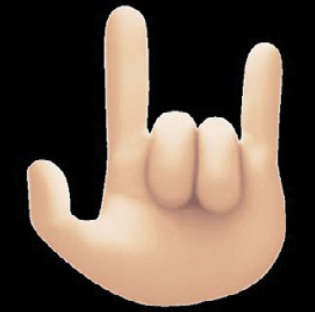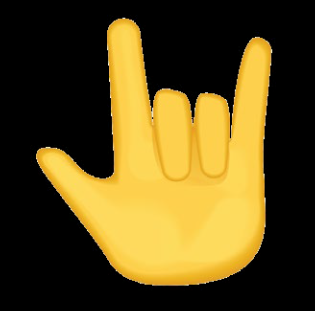This article was first published in the January 2024 issue of CITMA Review, the journal of the Chartered Institute of Trade Mark Attorneys (CITMA). For more information on CITMA, please visit citma.org.uk.
Key points
- Emojis and other pictograms can be registered as trade marks; however, they must attain the minimum degree of distinctiveness required
- This case highlights the challenges associated with obtaining trade mark protection for emojis, given that they are prevalent in daily communication and consumers might not perceive them as trade marks
- Emojis can be protected under other IP rights, such as copyright and designs
Marks

The Käselow mark

'I love you emoji' example from Google search
An emoji must do more to be found distinctive
The EUIPO Board of Appeal (BoA) has recently considered in Käselow Holding GmbH (Käselow) whether an emoji is capable of functioning as a trade mark or whether it would be perceived by consumers as a promotional message or decorative element. Although many emojis have been successfully registered as trade marks (eg the iconic ‘smiley face’ in the EU), this decision highlights the particular challenges surrounding the distinctiveness of these miniature icons. Emojis are small images/pictograms that are used to express a wide range of emotions (such as happiness or laughter) in electronic communication. Emojis were created in Japan in the 1990s and have since become commonplace worldwide in messaging apps and on social media, often used to bring to life the user’s message as a substitute for words. It is common for messaging apps and operating software to have slightly different renditions of emojis to correspond with their house style. Themed emojis, such as ‘Kimojis’ (featuring Kim Kardashian‑themed emojis) and those created using Bitmoji (an app where users can create personalised emojis and avatars), have also been very popular. On 16th December 2021, Käselow filed an EU trade mark (EUTM) application for a figurative mark depicting a cartoon‑style hand gesture (shown right) covering financial services in class 36 and cleaning and construction services in class 37. The EUIPO issued a provisional refusal against all services of the application pursuant to Article 7(1)(b) of the EU Trade Mark Regulation (EUTMR). In particular, the applied‑for sign was considered devoid of distinctive character given that it depicts an emoji used to indicate ‘I love you’.
Examination decision
The EUIPO Examiner upheld the refusal (in the Contested Decision), emphasising that the applied‑for sign would be considered a generic or common emoji symbol by consumers. In relation to the applied‑for services, the Examiner held that the average consumer would perceive the applied‑for sign as simply providing a positive connotation for such services or perhaps as a decorative element inviting consumers to make a purchase. The EUIPO stated that there was no distinctive element within the applied‑for sign that would enable consumers to distinguish the services offered by Käselow from those offered by third parties.
The Contested Decision featured detailed discussion on the meaning of the applied‑for mark, including whether the sign could be classified as an emoji, a smiley face, a hand gesture or a pictogram. The EUIPO stated that the hand gesture is well known to mean ‘I love you’ in American Sign Language (ASL), providing evidence by way of a Google image search (shown right). Käselow sought to refute this by arguing that the hand gesture was not generally known by EU consumers to possess this meaning and was not the ‘I love you’ symbol from ASL. Käselow outlined that the ASL sign depicted a right hand (as opposed to a left hand) and featured differing thumb positioning than the applied‑for sign. Käselow also argued that the applied‑for sign has many potential meanings and was not a smiley face, emoticon or gesture, casting doubt on whether it constituted an emoji either. The EUIPO rejected these arguments, stating that, pursuant to Article 7(2) EUTMR, where a lack of distinctiveness is found in relation to only one part of the EU (eg due to only some EU consumers identifying the sign as a common emoji) this would be sufficient to refuse the EUTM application.
Käselow appealed the Contested Decision, arguing: (i) the applied‑for sign is distinctive in relation to the applied‑for services; (ii) the sign could be considered as an emoji in the broader sense of the word, but emojis are not in and of themselves devoid of distinctive character or incapable of functioning as trade marks; (iii) the fact that a sign possesses a positive connotation does not mean that it is devoid of distinctive character; (iv) the sign is not an emoji that would fall under everyday use; (v) the sign noticeably differs from the hand gesture emojis referenced in the Contested Decision; and (vi) the sign does not mean (nor match the emoji for) ‘I love you’ under ASL.
Appeal outcome
The BoA upheld the refusal, finding that:
- The applied‑for sign is a common emoji meaning ‘I love you’.
- There are different variations of the ‘I love you’ emoji (including left‑handed versions) and under the principle of incomplete recollection, consumers would not notice the minor differences in the applied‑for sign.
- Generally, the main purpose of an emoji is to convey emotional references and express feelings and so “as a rule, they are not perceived as an indication of origin”. The BoA cited various cases where it was held that pictograms (including emojis) were perceived by the average consumer as promotional/decorative elements that are devoid of distinctive character1.
- As regards the applied‑for services, the average consumer would consider the applied‑for sign as a general advertising message or an indication of satisfaction with the services offered under the sign.
- The applied‑for sign failed to attain the minimum degree of distinctiveness and so was not capable of serving as a badge of origin.
This case highlights the potential challenges associated with registering emojis as trade marks, noting that they have become commonplace in everyday communication and consumers might not consider them as trade marks belonging to any particular entity. It is also important to consider the registrability of an emoji in the context of the applied‑for goods and services; these could fundamentally impact the likelihood of an emoji being considered as laudatory or merely decorative. However, it is possible to overcome the difficulties surrounding registration; for example, by adding distinctive written or figurative elements. Emojis may also be protected under other IP rights, such as copyright or by way of unregistered/registered designs.
Note: The original language of the decision is German.